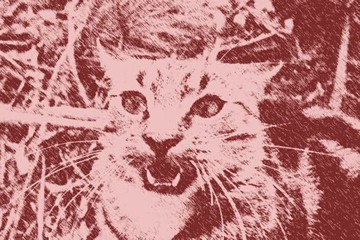The Invasive Species Council is warning that an ambitious program to eradicate feral cats from the Dudley Peninsula on Kangaroo Island is being undermined by an outdated law which stops feral cats being killed within 1km of a residential dwelling.
The call comes as new research shows feral cats’ devastating toll on Kangaroo Island’s unique wildlife.
Stomach content analysis (below) from 263 feral cats shows they prey on over 50 species, including critically endangered animals such as the Kangaroo Island dunnart.
‘Despite overwhelming community support for feral cat eradication efforts on Kangaroo Island, South Australia’s ambitious program is being undermined by an outdated administrative law that effectively creates feral cat havens,’ Invasive Species Council Advocacy Director Jack Gough said.
‘Under current laws, essential control tools like trapping and baits cannot be used by Landscape Board professionals within a 1km radius of residences, leaving the wildlife in significant areas of the Dudley Peninsula unprotected.
‘This bureaucratic issue can be solved with a simple amendment to the Dog and Cat Management Act to ensure that control tools, which are currently used in areas outside the 1km zone, can be used within the zone.
‘The vision to eradicate feral cats from the Dudley Peninsula, and ultimately the whole of KI, is supported by the overwhelming majority of the community.
‘Feral cats are very difficult animals to catch, particularly when the numbers are low, so achieving eradication requires land managers to have access to the full array of control tools. This includes traps, baits and new AI tools like Felixers.
‘Of course existing standard operating procedures and approval requirements would still apply under this change, with just the arbitrary distance restriction scrapped.
‘The environmental toll from feral cats is hard to overstate. By this time tomorrow, over 5 million native mammals, birds, reptiles and frogs will have been killed by the millions of feral and roaming pet cats in Australia.
‘Cats have driven at least 25 of our native species to extinction and without serious action to eradicate them, Kangaroo Island could lose iconic native wildlife like dunnarts, bandicoots and echidnas.
‘No one likes to see feral cats killed, but the sad reality is that we have a choice to make between effectively eradicating feral cats on Kangaroo Island or seeing native species like dunnarts and bandicoots disappear forever.’

Media inquiries: (02) 8006 5004
Photos and maps to accompany this story are available here.
Background:
- Kangaroo Island is internationally renowned for its biodiversity, agriculture, and tourism, contributing $200 million annually to nature-based tourism and $150 million to sheep production pre-bushfires.
- Its unique ecosystems support threatened species such as the Southern Brown Bandicoot, Kangaroo Island Echidna, and Western Whipbird. Feral cats are their primary threat, causing catastrophic declines in native species and spreading diseases like toxoplasmosis, which also impacts agriculture.
- The Dudley Peninsula Feral Cat Eradication Program (DPFCEP) has demonstrated that eradication is possible, with 202 cats removed between April and June 2024 using 600 traps.
- Section 63 (c) of the Dog and Cat Management Act 1995 prevents the killing of feral cats unless “the cat is found in a place that is more than 1 kilometre from any place genuinely used as a place of residence”.
Stomach content analysis from 263 feral cats:
| Species | Common name | Number of cats | % |
| Mus musculus | House mouse | 155 | 58.9 |
| Bird | 38 | 14.4 | |
| Rattus fuscipes | Bush rat | 19 | 7.1 |
| Beetle | 11 | 4.1 | |
| Skink | 9 | 3.5 | |
| Macropus eugenii | Tammar wallaby | 6 | 2.2 |
| Sminthopsis aitkeni | Kangaroo Island dunnart | 4 | 1.6 |
| Macropod sp. | 4 | 1.4 | |
| Macropus fuliginosus | Kangaroo Island kangaroo | 4 | 1.4 |
| Trichosurus vulpecula | Common brushtail possum | 3 | 1.3 |
| Sheep | 3 | 1.0 | |
| Pseudocherius peregrinus | Common ringtail possum | 2 | 0.7 |
| Snake | 2 | 0.7 | |
| Grasshopper | 1 | 0.5 | |
| Cat | 1 | 0.4 | |
| Varanid | Rosenberg’s goanna | 1 | 0.2 |
| Frog | 1 | 0.2 | |
| Ornithorhynchus anatinus | Platypus | 0 | 0.1 |
| Pig | 0 | 0.1 | |
| Total | 263 | 100 |









